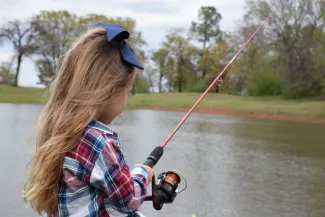It would be a dull world indeed if everyone had the same tastes. Trophy largemouth bass fishing seems to be the rage right now, but some of us just enjoy catching and eating larger bluegill. This section will deal with starting, managing, and maintaining a quality bluegill fishery in a farm pond.
First, start with a pond devoid of fish – one that is newly constructed or has been renovated with rotenone. Stock as for a balanced bass-bluegill pond.
Bluegill and channel catfish may be harvested starting the first fall season. Largemouth bass should not be harvested for three years. At that time, a minimum length limit of 12 or 14 inches should be placed on the bass population.
Feeding bluegill and channel catfish should be started the spring following stocking. Use a floating fish feed placed in a floating ring so you can easily observe the fish feeding. Fish can be fed daily in the warmer months when water temperatures exceed 65°F.

Provide only an amount of feed that can be consumed in about 10 minutes. If the fish do not feed well for two days, stop feeding and check the water quality (temperature and dissolved oxygen). If the equipment to check water quality is not available, try feeding the following week. Usually water quality will have improved by then and the fish will resume feeding. Reduce feeding to once per week when the water temperature cools in the late fall and winter. Never feed more than 15 pounds of feed per acre per day because excessive feeding can lead to low dissolved oxygen and result in a fish kill.
The stocking and feeding program described above should produce a quality bluegill fishery. The majority of bluegill caught will be more than six inches long and the bass population will be crowded with most less than 12 inches. Then you should manage the harvest of bluegill to prevent overcrowding the bass population to the extent that they consume all of the bluegill reproduction. If you are not seeing a good number of four-inch bluegill being caught along with the harvestable size (over six inches), then increase the harvest of largemouth bass until smaller bluegill are again present in the catch. One approach would be to remove 30, eight- to 12-inch bass per acre with a 12- to 18-inch protected length range.
A quality bluegill fishery is well worth the time and trouble it takes to achieve. Some ponds managed in this fashion have provided continuous good fishing for more than 15 years.